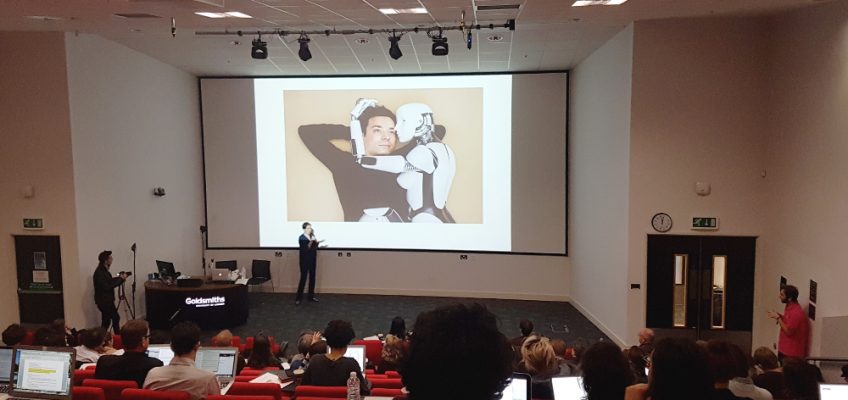Tracing the genealogy of sexbots from Greek mythology to today.
After being canceled amongst much controversy in Malaysia last year, the Second International Congress on Love and Sex with Robots finally took place in London this week, hosted at Goldsmiths, University of London.
As you might expect, there were some interesting gadgets such as haptic lollypops and kissing phones on show. But the bulk of the discussions revolved around philosophical—and increasingly topical—issues around both the morality and practicality of human-robot interactions in a not-so-distant future.
We will probably see the first robot-human marriages by 2050, but it could be a lot sooner Click To Tweet“What strikes me about the last few years is that advances in technology, and particularly in AI, have been happening much faster than we thought,” said David Levy, author of the book that lent its name to the conference (Love and Sex with Robots: The Evolution of Human-Robot Relationships).
When he first wrote the book, he predicted we would see the first human-robot marriages by 2050. But—much like the exponential AI advances we’ve experienced with Google DeepMind—things are moving at a much more accelerated pace than initially predicted:
“So although this might appear to be a long way off, you can never tell about the future, and if you think it won’t happen in your lifetime, you’re probably wrong. I still think it will happen by 2050, if not sooner.”

After being canceled amongst much controversy in Malaysia last year, the Second International Congress on Love and Sex with Robots finally took place in London this week, hosted at Goldsmiths, University of London.
When he first wrote his book, Levy predicted we would see the first human-robot marriages by 2050 Click To TweetAs you might expect, there were some interesting gadgets such as haptic lollypops and kissing phones on show. But the bulk of the discussions revolved around philosophical—and increasingly topical—issues around both the morality and practicality of human-robot interactions in a not-so-distant future.
“What strikes me about the last few years is that advances in technology, and particularly in AI, have been happening much faster than we thought,” said David Levy, author of the book that lent its name to the conference (Love and Sex with Robots: The Evolution of Human-Robot Relationships).
When he first wrote the book, he predicted we would see the first human-robot marriages by 2050. But—much like the exponential AI advances we’ve experienced with Google DeepMind—things are moving at a much more accelerated pace than initially predicted:
It will be so much easier, so much more convenient to have sex with a robot, and it will be exactly the kind of sex that you want, so that’s going to be the future Click To Tweet“So although this might appear to be a long way off, you can never tell about the future, and if you think it won’t happen in your lifetime, you’re probably wrong. I still think it will happen by 2050, if not sooner.”
Sexbots in storytelling
In order to prepare for the challenges that this will bring, we have a lot of work to do, however. And the conference showcased some interesting research on storytelling that serves to frame the moral dilemmas we will be faced with.
Julie Wosk, a professor at SUNY Maritime College in New York, traced the evolution of such stories from films such as The Stepford Wives (1976, 2004), where men want their sex robots to be soothing, adoring creatures who are always cheerful and entirely compliant with their desires, to the 2013 drama The Good Girl by Australian playwright Emilie Collyer, in which a sex doll working in a futuristic urban brothel is reprogrammed to combat a patron’s boredom, with dire consequences.
According to Wosk—who explored this age-old quest by men to create the “Perfect Woman” in her book My Fair Ladies: Female Robots, Androids, and Other Artificial Eves—stories such as these show that we’re already anticipating how our complicated human psyche will deal with having actual long-term relationships (sexual or otherwise) with machines.
When we try to anticipate the future, our cognitive parameters and frames are shaped by the past Click To Tweet“Collyer’s play offers a glimpse of the world we may be creating for ourselves in the future,” Wosk said. “In many Sci-Fi tales about men with robot women, the men like facsimile females because they are soothing and fulfill all their desires.”
“But in The Good Girl,” she added, “some of the male clients want more than mere pleasurable sex dolls…Men who used to be happy with women who were submissive and sweet now find that boring and ‘want something more. Terror. Or anger. Desperation. Rape.’ There is even a male client who wants jealousy, paranoia, and rage—‘like relationships used to be.’”
Genealogy of the sex robot
The exploration of such issues through storytelling is nothing new according to Dr. Genevieve Liveley from Bristol University. According to Liveley, both side of the “sex with robots” debate are engaged with a type of myth making, because when we create new technology we’re not only creating new devices, but also new narratives to help us make sense of it:
“As a Historian, I’m minded that when we try to anticipate the future, our cognitive parameters and frames are shaped by the past. We are really rubbish at anticipating the future with any certainty, so one of the ways we try and do it is by telling stories,” she explains. “And as long as we’ve been telling stories it turns out we’ve been talking about robots, cyborgs, and sex with robots.”
That becomes self-evident during her talk where she unpacks classic Greek and Roman myths of men and women giving life to creatures that are remarkably similar to our visions of modern cyborgs, starting with the classic story of the sculptor Pygmalion in Cyprus, who manages to bring the ivory statue of his idealized woman to life.
“If you’re charting the evolution, the genealogy of the sex robot, you go back to Pygmalion; he’s sort of the great-granddaddy of the sex robot. It’s actually a dystopian perspective of the human-machine relationship than you might initially think. These stories are really complicated, and quite often dark.”
Interestingly, she goes on to explain how in those ancient stories the narratives see both men and women as hybrid beings wrought by clay and fire (look up the tale of Prometheus and Pandora for more on that). According to that view, we’re all inherently artificial creatures, or as Liveley so eloquently puts it “Promethean proto-cyborgs.”
So the real question, which those ancient and modern myths might help us get to grip with, is not whether we will be having sex with robots anytime soon, but what those deeper and broader relationships with our creations will look—and feel—like when we do.
Because, as Professor Adrian David Cheok told the conference when asked for his own prediction on where the future of this area would lead, sex was pretty much a given:
“It will be so much easier, so much more convenient to have sex with a robot, and it will be exactly the kind of sex that you want, so that’s going to be the future, we’ll have more sex with robots. But the next stage is love.”
This article was originally published on the Future of Sex website
How a History of Storytelling Can Help Us Make Sense of Sex with Robots https://t.co/94i9rYRSvQ #LSR16 #robots
— FutureofSex (@FutureofSex) December 23, 2016
Alice Bonasio is a VR Consultant and Tech Trends’ Editor in Chief. She also regularly writes for Fast Company, Ars Technica, Quartz, Wired and others. Connect with her on LinkedIn and follow @alicebonasio and @techtrends_tech on Twitter.









